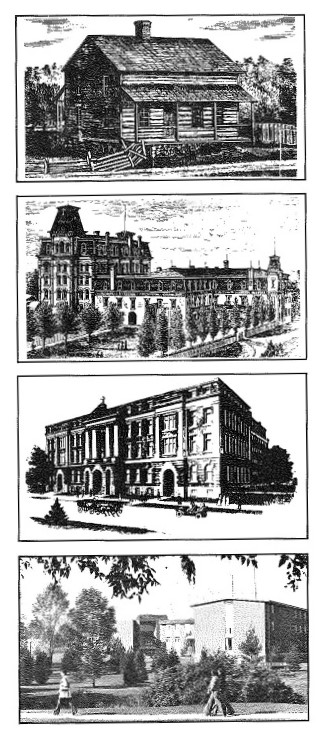
SJU: Through The Ages
Introduction
Panels
IntroductionSJU Architectural History: 1864 - 2023ReferencesLinks
St. Jerome's University: Mission, Vision & HistoryWaterloo Catholic District School Board: St. Jerome's History
St. Jerome's: Then and Now Details
"Lord, I have loved you but late, too late," Grieved St. Jerome as he pondered his past. But I, I have loved you from the first, From the day when first I stood before Your pleasant facade, O most excellent of schools.
Now I too grieve as you pass into history. The highest of accolades always were yours. Once gladiators going into combat hailed the emperor so: "We who are about to die salute you." Tis you that I salute, O noble lady, soon to die.
Ave atque in aeternum vale. Hail, most beloved school, And farewell forever.
There will not be the like of you again.
Written by Dr. Albrecht Ua Siaghail. Translation by Lorraine Green. Published in The Fifth Quarter: A History of St. Jerome’s (Karges & Green, 1989, p. vii).
St. Jerome's University: Through the Ages
St. Jerome's University came from humble beginnings, as a small log cabin school for boys (Spetz, 1915). It was co-founded in 1865 by Reverend Louis Funcken, C.R. and his brother Father Eugene Funcken, C.R., under the administration of the Congregation of the Resurrection and the patronage of the Bishop of Hamilton (Junker, 2021; McLaughlin et al., 2002; Waterloo Catholic District School Board [WCDS], n.d.). The purpose of the school was to teach Christian living to young men and to prepare them for higher study in the seminary, university, or for business (McLaughlin et al., 2002; St. Jerome's College [SJC], 1925). Over the years, the school drew in more students, faculty, and staff. The architectural history of the school reflects its willingness to adapt and respond to the needs of its population: from its modest one-room schoolhouse to a 990-acre contemporary Roman Catholic university, federated with the University of Waterloo (McLaughlin et al., 2002). This exhibit reflects the history of St. Jerome's University, as seen through its architecture, from its founding in the late 19th century to its modern construction in the 21st century.


